Video Transcription
Hey everyone, its Nathan with Crown & Caliber and we are back with you guessed it another Rolex video, but let me first give some context to this video. Recently we did a video on how to speak Rolex in which we went through and highlighted a bunch of terms that we thought were super important to know when getting into the Hobby of watches. And a lot of them happen to originate from Rolex as a brand and in this we had a realization that there are a lot of quirks and idiosyncrasies with the Rolex brand that we at Crown & Caliber have realized because we see so many watches and we get to compare models side-by-side that you as a general consumer may not have the opportunity to recognize. And so, we want to go ahead and highlight a lot of these nuances and we think these nuances do two things. First off, we think they kind of dispel a myth in the sense that if you go ahead and look at the vintage Rolex market so many of the things that are prized are things like tropical dials and spider dials and these were inherently production defects from Rolex.
And over the years as the brand became more and more automated there’s a thought that maybe these disappeared and granted these maybe aren’t as glaring as they once were but all of the nuances and quirks that we’re showing today are effectively contemporary watches that exist in the past 25 years. And it’s also worth mentioning that here at Crown & Caliber, because we get to see so many watches we do begin to recognize these patterns and then from these patterns were able to begin to speculate as to why these Rolex quarks even exists and something that is really interesting about a lot of these Rolex quirks is just how granular they are and we think it’s really interesting because it pulls back the green curtain on the pursuit of perfection for Rolex and ultimately it gives you perspective on why two seemingly identical Rolex models and have such a vast price difference. So, let’s get started.
Anti-Reflective Rolex Submariner Cyclops

Alright so first up in our Rolex quirks involves the Cyclops and specifically we’re going to be looking at the Cyclops on Submariners and even more specifically the end of the five-digit Submariner prior to the six-digit ceramic Submariner. So, with the release of the six-digit ceramic Submariner the 116610, the Cyclops gained an anti-reflective coating. This allowed someone to be able to see the date at more angles and just made for a more clear view of the date but toward the end of the five digit Submariner apparently Rolex ran out of crystals and started using crystals for its successor the six digit Submariner with the anti-reflective coating. So, you can effectively find a late five digit Submariner that actually has the anti-reflective coating under the Cyclops. And as small and as granular as that may seem it does show us something. It shows us that there is some discrepancy between the production and inventory and the product launch.
SEL Bracelets with Pierced Lugs on Rolex Submariner, GMT-Master II, and Explorer II
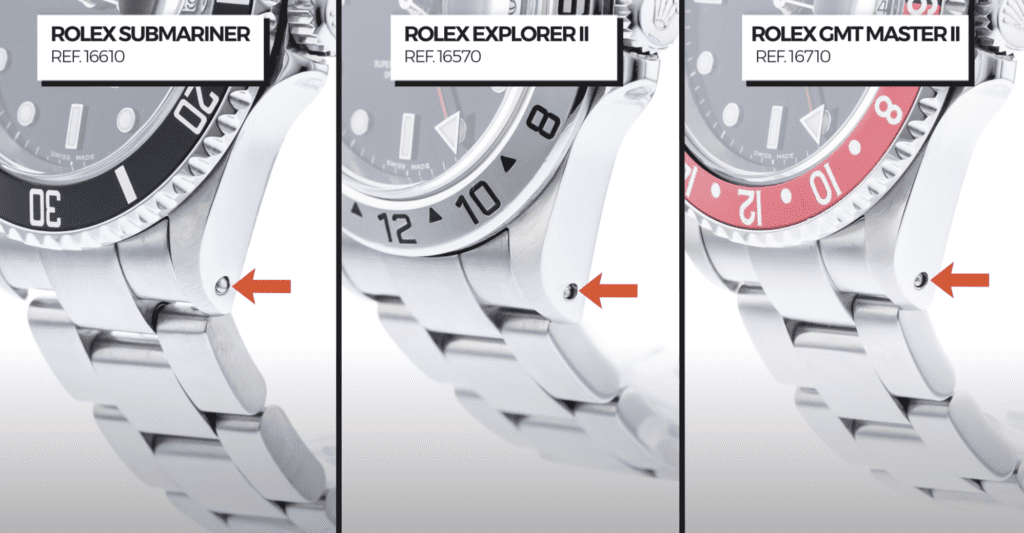
Alright so up next we are still going to stick with stainless steel sport models and specifically we’re going to look at the Rolex Submariner the Rolex Explorer 2 and the Rolex GMT Master II. Now we’re going to look at these watches from the early 2000s so around 2001. Now what happened is these watches all gained solid end link bracelets. Now we’ve talked about that term before and really quickly what that means is the two links of the bracelet that connect to the watch head are milled from solid blocks of stainless steel resulting in a much more secure fit with the bracelet and the watch head.
Now this is especially unique because it took a couple of years before those three models were updated to the transitional reference, so the Submariner went from the 16610 to the 16610T, as in transitional. Which in and of itself is kind of interesting because it shows that Rolex is in a transitional stage but with that reference the lug holes were closed off and why this is kind of unique is there were a few years where you could get a solid end link bracelet, so creature comforts of say a modern watch, with some of the more nuanced vintage style of the pierced lugs and even furthering that point some of the other models like the no date Submariner the 14060 in its entire life never received a solid end link bracelet. So I think this goes to show a couple of things as Rolex is updating their models we don’t know what they’re doing we don’t know why they’re doing what they’re doing we can only speculate and secondarily there’s not always a clean break for every model and every distinction and every upgrade.
Rolex GMT-Master II Stick Dial

Now we’re going to be looking specifically at the Rolex GMT-Master II, the 16710. Now this watch was discontinued in 2007-2008 and replaced by the ceramic GMT-Master II, the 116710, but back to its predecessor. Toward the end of its life something unique happened. On the dial it says Rolex GMT-Master II, and GMT-Master II is a Roman numeral and for some reason and this is the beauty of Rolex the II, the Roman numeral switched to just an “I” “I” so two capital I’s. No longer a Roman numeral. We don’t know why Rolex did this and this is part of the beauty on why people collect watches but nevertheless it is a small detail that represents kind of a transitional model that in some instances Rolex doesn’t even acknowledge it just happened. So, in late 16710’s you’ll see that the Roman numeral in GMT-Master II is replaced by two capital “I”s and this was affectionately known as the stick dial.
The Rolex Calibre 3186
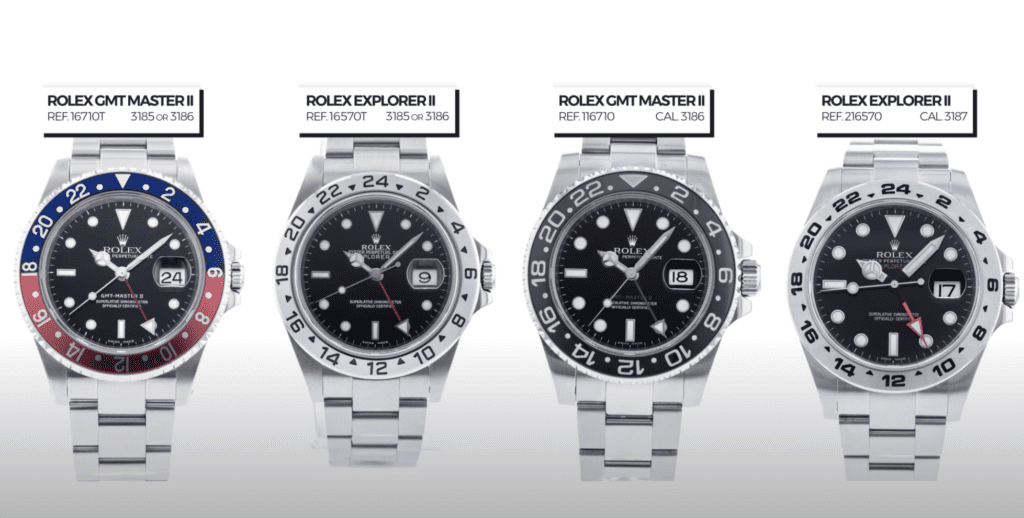
Alright guys so we are going to continue down the Rolex rabbit hole as I like to call it and fair warning this example that I’m about to give is dense. To call this granular would be an understatement but stick with me because this is some great information. So, we’re going to be looking at the Rolex GMT-Master II, the 16710 and the Rolex Explorer 2 the 16570. Now these two watches shared something in common they both used Rolexes GMT complication the caliber 3185 and here’s where things get interesting toward the end of the production of these two watches the caliber 3185 actually ceased production sooner.
So now you have a Rolex GMT-Master II and a Rolex Explorer 2 in need of a movement. So what Rolex does is they go ahead and put the newer calibre 3186, which would eventually arrive in the successor to the GMT-Master II, the 116710. They took that caliber 3186 and put it both in late GMT-Master II’s and late Explorer 2s. Now where things get even a little more complicated is the successors come along. You have the ceramic GMT-Master II the 116710 with the calibre 3186 and then you have the larger 42-millimeter Explorer 2, 216570, with a different caliber, the 3187. It was a larger calibre for the larger movement and that’s because Rolex does what they want. Ultimately it shows again there are not clean breaks product launches and inventory doesn’t always line up and what you end up with is a pretty dense and confusing history. Oh yeah that was dense. We got through that. It was like swimming through peanut butter but we’re on the other side and we’re moving forward.
Service Laser Etched Coronet/Crystal
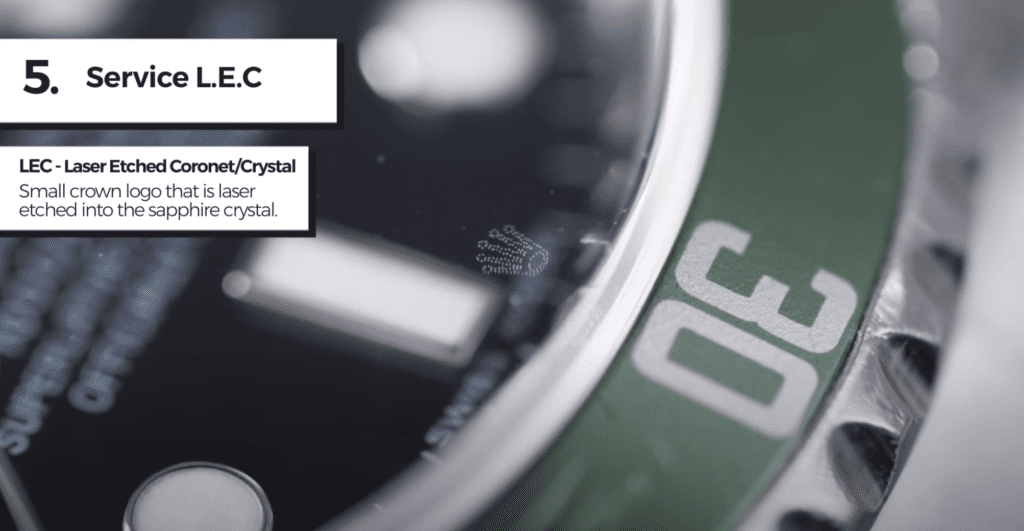
So, this one is fun. So, you may have often heard the term LEC or laser etched coronet. Basically, that refers to in the early 2000s Rolex started laser etching a small cornet or crown onto their crystals to help prevent from fraudulent watches being produced. It’s kind of a cool thing to find on your watch if you have one that would have it but take it a little further. If you were to send a watch into an authorized Rolex service center for service and they replaced the crystal and it was supposed to have this LEC that replaced crystal still has an LEC but if you look, and this is hard to find. If you look in the small opening of the coronet there is a sideways S denoting that it is a service replacement crystal. So gotta… gotta look hard for that one but that is a really quirky fun way to see that not only is it an authentic Rolex crystal but is an authentic Rolex service crystal. I think this is a cool way in which Rolex is able to kind of leave breadcrumbs to the history of a watch.
The Explorer’s 3,6, and 9
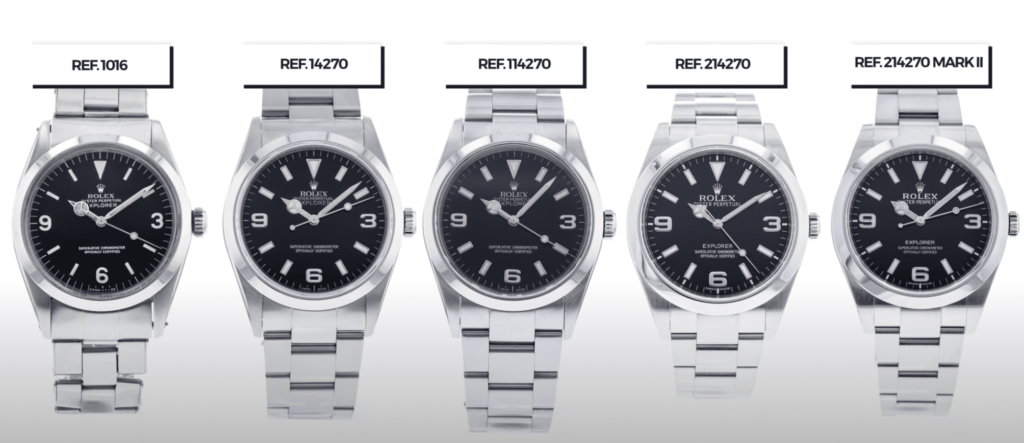
All right so this next Rolex quirk won’t take nearly as long to explain but it did take about 30 years to occur. So, we’re going to start in the 80s with the Rolex Explorer the 1016. This is an iconic watch and part of it is with its three, six, and nine Arabic dial and the luminescence thereof. Now its successor the 14270 still had the Arabic three, six, and nine dial, but the three, six, and nine were no longer luminescent. Even though they looked similar to the remaining hour markers they didn’t have a lume, and in a sport watch luminescence is important so that’s kind of confusing, but don’t worry Rolex then updates it to its successor the 114270 and it still doesn’t have a loom in the three, six, and nine though it looks like it does. And then they come along with the Rolex 214270, the next successor, and not only does it not have lume, now it’s high polished gold and it doesn’t even look like the rest of the hour markers, but eventually Rolex does get things right with the Rolex 214270 Mark II in 2016 That finally had lumed at three, six, and nine Arabic numerals again like its predecessor the 1016.
5-Digit Bracelets vs. 6-Digit Bracelets
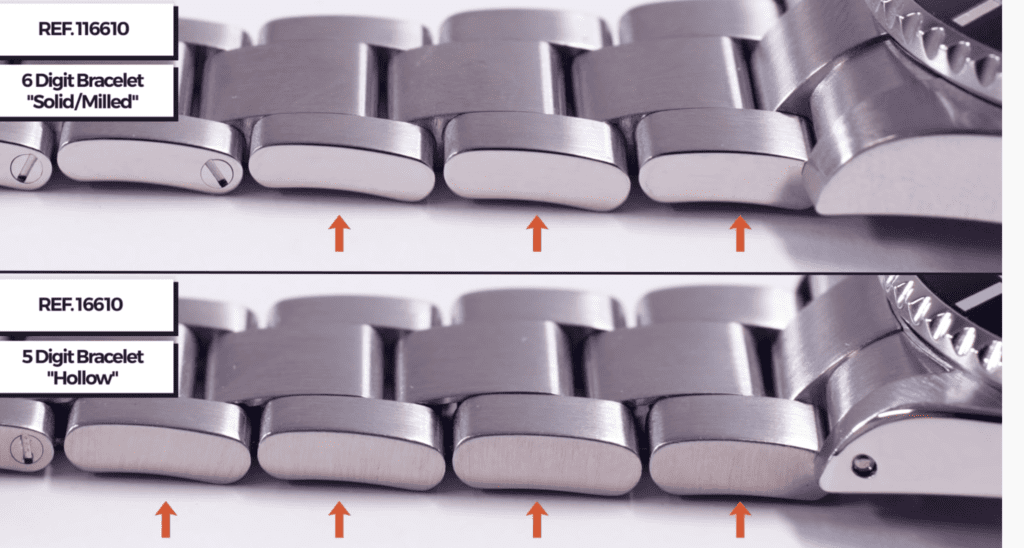
All right so this next Rolex idiosyncrasy isn’t necessarily a production issue or let’s say a mistiming. This is something that doesn’t affect everyone, but we believe is worth mentioning. So older Rolex watches have hollow bracelets. Now this doesn’t necessarily apply to hollow end link versus solid end link but rather to the center links of the bracelet this applies to either the Jubilee or the Oyster and a lot of these older bracelets had a flaw you could not remove as many links on the six o’clock side and what that means is if you are holding the watch up the bracelet that comes off at the bottom the six o’clock side they didn’t have as many links that could be removed. So it ultimately happens is if you have a wrist size under or around six and a half inches all of the sudden the clasp doesn’t sit as well as it should on the wrist and again this isn’t a problem for everyone but it’s something to consider if you are on the smaller wrist size and are looking at any reference that does not have a solid bracelet. So, a good rule of thumb is if it is a five-digit reference then it will not have a completely milled solid bracelet and that is something to consider.
The Rolex Flat 4
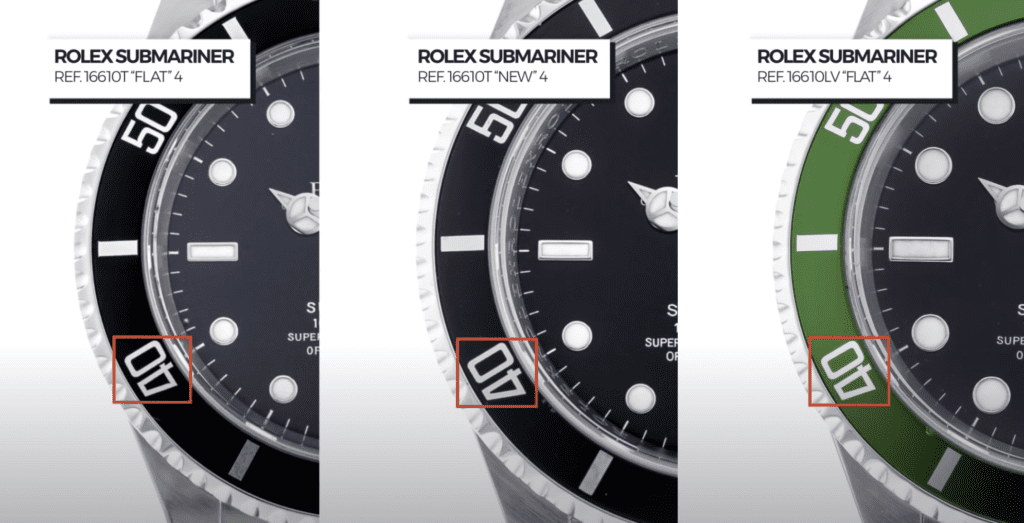
Alright so this little Rolex quirk is a doozie and what we’re going to be talking about is the Rolex flat 4. Now the flat 4 refers to the four in the number forty on a dive bezel of a Rolex Submariner. Now basically the Rolex four had a flat section to it and in later years that was replaced by an updated font that was pointed. Now where things get a little sticky is the anniversary Submariner the Rolex 16610LV that had a maxi dial and a green bezel came along around the same time that Rolex was it changing the font on the bezel. So what you get is a potential Rolex Kermit, as it is known, with a flat 4 bezel before they were discontinued and that became something that is very rare and thusly fetches quite a premium in the pre-owned market and it’s all just because it has a flat 4 on the bezel.
The Daytona Lugs
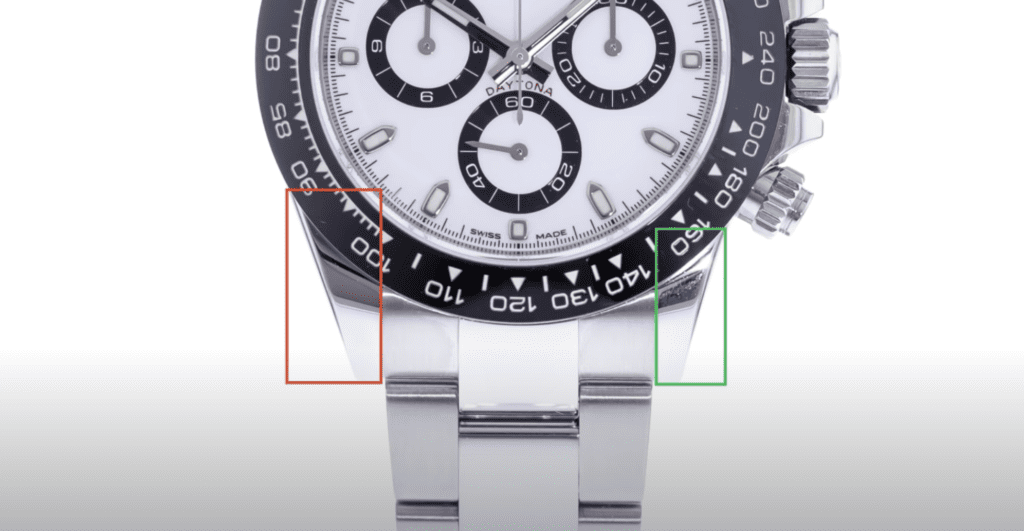
So, this one is this one is truly mind-boggling to me. I have been somewhat outspoken in my opinions on a Daytona for many a reason but one of which is if you look at a Daytona stainless steel you will notice that the lugs are not symmetrical. What I mean is the two lugs at the bottom are not symmetrical. The two lugs at the top are not symmetrical. Now the lugs on the right-hand side of the watch are and the lugs on the left-hand side of the watch are. And I speculate this is because of a milling process to make sure that the pushers in the Daytona are easier to access. So basically, the right-handed lugs are slightly thinner or have a slightly different taper than the left-handed lugs. Now that’s not crazy to any means. To me, someone that is very particular, I cannot look at a Daytona and not see the uneven lugs and that that has just existed for quite some time. And if that’s not enough… This would have been about six months ago we received in an anniversary platinum Daytona and I looked at it and I realized that the lugs were symmetrical, and I thought I had gone crazy. So, I went and looked at another precious metal Daytona and sure enough the lugs were also symmetrical. I don’t know why, but basically side by side a stainless-steel Daytona and a precious metal Daytona have different lugs.
All I can speculate is that it has something to do with the production of the watch, but my question is why would the production follow the function of the watch? If the function of the chronograph pusher is not inhibited by the thicker lugs on the precious metal Daytona, then why wouldn’t it exist on the stainless steel. My other thought is maybe the precious metal lug cannot be thinner because of it being a precious metal being a softer metal but if that is the case then inherently you’re not inhibited in using the pusher of the chronograph so then why wouldn’t the lugs of the stainless steel be just as thick and symmetrical. I truly don’t know.
To me this is probably one of the quirkiest contemporary, this is current, Rolex quirks. So, I hope I didn’t ruin Daytona for anyone and I’m excited to hear what people think about it but that one is truly fascinating. Alright everyone so that is going to wrap up our crazy quirky Rolex idiosyncrasies that we’ve seen here at Crown & Caliber and I think it’s worth mentioning as we do wrap this up, but not every anomaly or idiosyncrasy has some motive behind it you know Rolex wasn’t necessarily planning something or doing something and I think that’s worth keeping in mind but that being said we would love to hear what you think about the crazy Rolex quirks that we’ve discovered or that we have noticed and also let us know of any crazy Rolex quirks that you have discovered and as always guys thanks for watching.
Get More Articles Like This in Your Inbox
We're constantly creating great content like this. So, why not get it delivered directly to your inbox? By subscribing you agree to our Privacy Policy but you can unsubscribe at any time.





